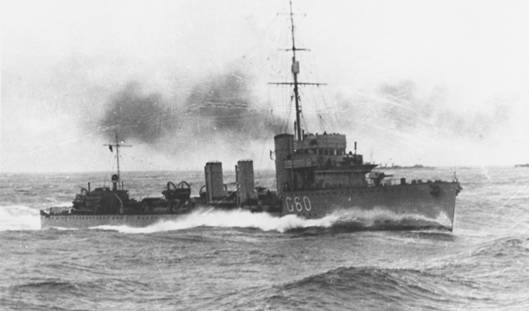- Author
- A.N. Other and NHSA Webmaster
- Subjects
- Ship histories and stories, History - Between the wars
- Tags
-
- RAN Ships
- HMAS Anzac I
- Publication
- March 2011 edition of the Naval Historical Review (all rights reserved)
In naval terms a flotilla is a small fleet. The role of the flotilla leader was to operate as the spearhead of the group of destroyers, acting as the headquarters ship and providing additional accommodation for the captain and his staff. The leader possessed a more powerful armament, wider radius of service and, normally, a speed equal to or greater than the other units of the flotilla.
The two year old Anzac became the RAN’s first flotilla leader in 1919, when she was presented as a gift from the Royal Navy to Australia, along with five Admiralty ‘S’ class destroyers. Because of her name she was the logical ship of the ‘Marksman’ class to be selected for formal transfer in commemoration of the deeds of the Anzac forces at Gallipoli in 1915.
Built as a unit of the later ‘Marksman’ class, but also known as ‘Lightfoot’ (development of the ‘Nimrod’) class of flotilla leaders, this group differed from the original ‘Marksman’ in that the two forrard funnels were trunked into one large funnel, and a super-firing gun was mounted before the bridge. Anzac was the odd man out in this class, in that her foc’sle was raised one foot during building. It had been hoped to raise the foc’sle with all members of the later ‘Marksmans’ but the others were too far advanced in construction.
During her 14 year career in Australian waters Anzac was allotted the pendant number G90, but like all leaders, the pendant was never painted up on her hull. She was formally commissioned into the RAN on 27 January 1920, introducing into Australian service for the first time the more effective super firing guns (mounted in A and B positions before the bridge) and twin 21 inch torpedo tubes. As well, she was the only three funnelled destroyer to serve with the RAN.
Anzac served mainly along the eastern Australian coast, sailing to New Guinea and New Britain in 1924, 1926 and 1930. During the massive defence cutbacks of the Great Depression, the ship was the only destroyer retained in active service. Following decommissioning in July 1933 Anzac was stripped of all valuable equipment, and then sunk off Sydney as a target on 7 May 1936.
Armament
Four 4 inch Quick Firing MK IV guns were carried in A, B, Q, and Y positions. B was superimposed on the forrard shelter deck, commonly known as B deck. She was the first Australian destroyer to carry the super-firing gun. Q gun was carried on a bandstand between the second and third funnels, Y gun being mounted on the quarter deck. These guns were carried in pedestal P IX mountings and were low angle mountings, being capable of 20° elevation. For the 4 inch guns, 120 rounds per gun were carried. The two 2 pounder pom poms in single mountings were fitted for anti-aircraft defence, one being mounted on a small platform abaft the forrard funnel, the other on the after shelter deck. Ammunition supply was at the rate of 120 rounds for the 4 inch guns and 1000 rounds per gun for the pom-poms.
Anzac was fitted with two twin revolving deck mounts of the ‘close fit’ type. These tubes were made of bronze and could be put out of action by a moderate blow to the tube. Black powder was used as the firing charge and cleaning the tubes after firing was not a greatly sought after job. Later ships adopted the loose fit steel tubes, in which an effective gas check ensured the torpedo being able to receive the full force of the burning cordite propellant, but at the same time a very hefty blow to the casing would have been needed to jam the ‘fish’ in the tube.
Machinery
Anzac was the last Australian destroyer to have three screws and direct drive turbines.

Image courtesy of RAN
With the triple screw installation, the arrangement of the steam flow through the turbines was quite odd. The late Commander (E) W.H.S. Rands, RAN, who was at one time her engineer officer, had this to say about her:
‘She was somewhat of a freak and had the most extraordinary machinery arrangement. For cruising, the steam went first to the HP cruising turbine on the starboard shaft, then to the MP cruising turbine on the port shaft. Then to the HP main on the centre shaft, then to two LP turbines on the port and starboard shafts. The astern turbines were incorporated in the LP turbines on the port and starboard shafts. There was no astern turbine on the centre shaft. To go astern, you unclutched the HP and MP cruising turbines and then poured steam into the astern portion of the LP turbines on the wing shafts. For a while therefore, when going astern, you had a rather disconcerting situation of the two wing shafts grinding away astern, and the centre shaft drifting happily around ahead. The engine room had other amusing and amazing features. The air pump for the port engine was on the starboard side of the engine room, the starboard engines air pump was fitted on the port side.’’
The boilers were housed in one double and two single rooms. Three funnels were fitted, the larger forward ‘stack’ serving two boilers. The other two funnels served one boiler each and were quite small. To save deck space, the after funnels were ‘set-in’ sideways with the fore and aft dimension being only about one third of the width. A side-on view of this funnel arrangement left a lot to be desired.




